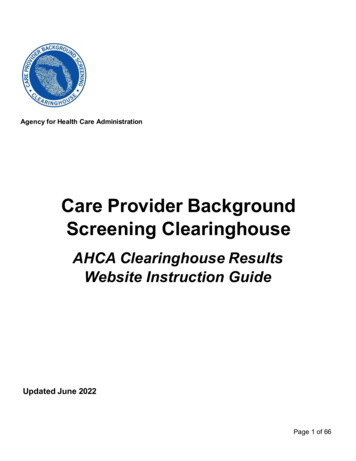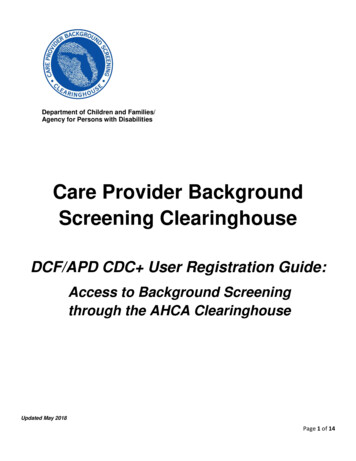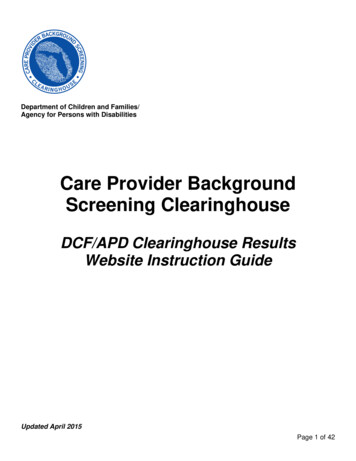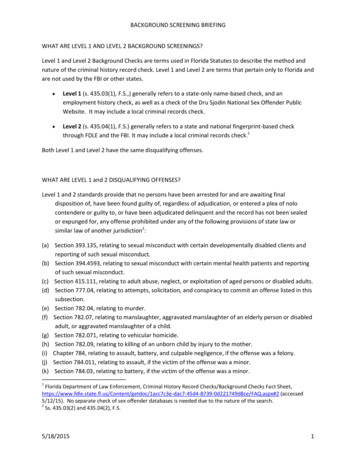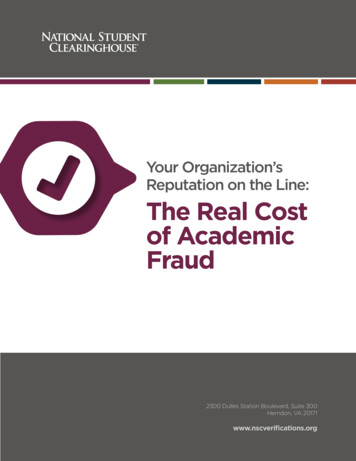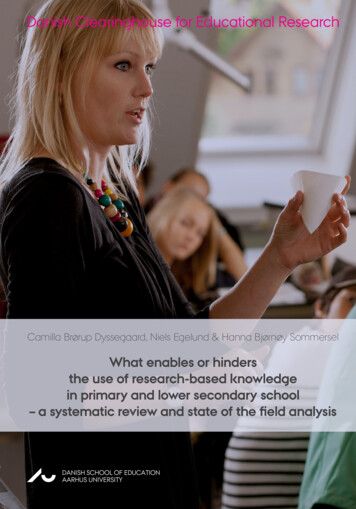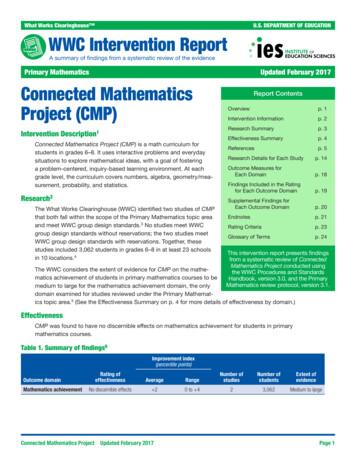
Transcription
What Works Clearinghouse U.S. DEPARTMENT OF EDUCATIONWWC Intervention ReportA summary of findings from a systematic review of the evidencePrimary MathematicsUpdated February 2017Connected MathematicsProject (CMP)Intervention Description1Connected Mathematics Project (CMP) is a math curriculum forstudents in grades 6–8. It uses interactive problems and everydaysituations to explore mathematical ideas, with a goal of fosteringa problem-centered, inquiry-based learning environment. At eachgrade level, the curriculum covers numbers, algebra, geometry/measurement, probability, and statistics.Research2The What Works Clearinghouse (WWC) identified two studies of CMPthat both fall within the scope of the Primary Mathematics topic areaand meet WWC group design standards.3 No studies meet WWCgroup design standards without reservations; the two studies meetWWC group design standards with reservations. Together, thesestudies included 3,062 students in grades 6–8 in at least 23 schoolsin 10 locations.4Report ContentsOverviewp. 1Intervention Informationp. 2Research Summaryp. 3Effectiveness Summaryp. 4Referencesp. 5Research Details for Each Studyp. 14Outcome Measures forEach Domainp. 18Findings Included in the Ratingfor Each Outcome Domainp. 19Supplemental Findings forEach Outcome Domainp. 20Endnotesp. 21Rating Criteriap. 23Glossary of Termsp. 24This intervention report presents findingsfrom a systematic review of ConnectedMathematics Project conducted usingthe WWC Procedures and StandardsHandbook, version 3.0, and the PrimaryMathematics review protocol, version 3.1.The WWC considers the extent of evidence for CMP on the mathematics achievement of students in primary mathematics courses to bemedium to large for the mathematics achievement domain, the onlydomain examined for studies reviewed under the Primary Mathematics topic area.5 (See the Effectiveness Summary on p. 4 for more details of effectiveness by domain.)EffectivenessCMP was found to have no discernible effects on mathematics achievement for students in primarymathematics courses.Table 1. Summary of findings6Improvement index(percentile points)Rating ofeffectivenessAverageRangeNumber ofstudiesNumber ofstudentsExtent ofevidenceNo discernible effects 20 to 423,062Medium to largeOutcome domainMathematics achievementConnected Mathematics ProjectUpdated February 2017Page 1
WWC Intervention ReportIntervention InformationBackgroundCMP was developed by Michigan State University and is distributed by Pearson Education. Address: P.O. Box6820, Chandler, AZ 85246. Email: k12customerservice@pearson.com. Web: https://connectedmath.msu.edu/.Telephone: (800) 848-9500.Intervention detailsCMP is an inquiry-based mathematics curriculum. Mathematical ideas are embedded in sequenced sets of tasksand explored in depth to help students develop a thorough understanding of mathematical concepts. Throughoutthe curriculum, students focus on problem-solving strategies, communicating their reasoning, offering proofs, andusing representations.CMP includes four courses: Grade 6 Mathematics, Grade 7 Mathematics, Grade 8 Mathematics, and Algebra I.Each course is organized into units, with seven to eight units per course, with units organized around a mathematical concept or set of related concepts, such as area and perimeter, or operations on fractions.7CMP seeks to promote students’ mathematical knowledge and understanding by helping them understand theconnections among mathematics topic areas and between mathematics and other academic subjects. Studentsmove flexibly between graphic, numeric, symbolic, and verbal representations to develop fluency in conceptual andprocedural knowledge.The publisher is currently selling the third edition of CMP. The developer’s website describes how the curriculumhas been refined and enhanced from the first and second editions.8CostAs of July 2016, the cost of CMP varies between 73.97 and 127.97 per student for the full curriculum, dependingon the grade level and type of implementation (digital, print, or a combination of formats). Manipulatives kits costbetween 221.97 and 313.47 each, and a teacher resource kit costs 524.97. More detailed cost information isavailable from the publisher.Connected Mathematics ProjectUpdated February 2017Page 2
WWC Intervention ReportResearch SummaryThe WWC identified 24 eligible studies that investigated the effects ofCMP on the mathematics achievement of primary students. An additional 72 studies were identified but do not meet WWC eligibility criteriafor review in this topic area. Citations for all 96 studies are in the References section, which begins on p. 5.Table 2. Scope of reviewed researchGrade6, 7, 8Delivery methodWhole classIntervention typeCurriculumThe WWC reviewed 24 eligible studies against group design standards.None of the 24 studies are randomized controlled trials that meet WWC group design standards without reservations.Two of the 24 studies use quasi-experimental designs and meet WWC group design standards with reservations. Thosetwo studies are summarized in this report. The remaining 22 studies do not meet WWC group design standards.Summary of studies meeting WWC group design standards without reservationsNo studies of CMP met WWC group design standards without reservations.Summary of studies meeting WWC group design standards with reservationsCai, Wang, Moyer, Wang, and Nie (2011) examined the effect of the CMP curriculum by matching seven schoolsusing the CMP curriculum to seven schools not using the curriculum on comparable demographic characteristics.All 14 schools were located in a single large, urban school district. Students in the intervention schools used CMPin the sixth, seventh, and eighth grades. Students in the comparison schools did not use CMP. The study involveda single cohort of students who were followed over six school years (2005–06 through 2010–11), from grade 6 tograde 11.9 All but the analyses of ninth and tenth grade outcomes meet WWC group design standards with reservations. The WWC based its effectiveness rating on outcomes measured at the end of eighth grade. The eighth-gradeanalytic sample included 303 students in the CMP group and 303 students in the comparison group in 14 schools.The study used the first edition of CMP.Ridgway, Zawojewski, Hoover, and Lambdin (2002) conducted a study using a quasi-experimental design in whichtwo classrooms from each of nine sites across the country used CMP. Five sites were in the Midwest, two were in theWest, and two were in the East. For every two CMP classrooms, one non-CMP classroom was recruited for the study.The authors matched the CMP classrooms to non-CMP classrooms based on student ability, urbanicity, diversity instudent population, and algebra or pre-algebra tracks. In five sites, there were both CMP and comparison classrooms.In the other four CMP sites, comparison classrooms were recruited from other locations. Data for the sixth- andseventh-grade analytic samples were collected in the 1994–95 school year and included 36 CMP classrooms and 18comparison classrooms. Data for the eighth-grade sample was collected in the 1995–96 school year, and included 14CMP classrooms and seven comparison classrooms. The WWC based its effectiveness rating on outcomes combined across students in all three grades. Although some intervention students used CMP in a previous school year,the findings from this study measure the effectiveness of receiving 1 year of the intervention because the pre-intervention measures were assessed at the beginning of same school year in which outcomes were measured. The analyticsample included a total of 2,456 students across these 75 classrooms. The study did not specify which edition ofCMP was used, but based on the timing of the study, it was likely the first edition.Connected Mathematics ProjectUpdated February 2017Page 3
WWC Intervention ReportEffectiveness SummaryThe WWC review of CMP for the Primary Mathematics topic area includes student outcomes in one domain: mathematics achievement. The findings below present the authors’ estimates and WWC-calculated estimates of thesize and statistical significance of the effects of CMP on primary students. Additional comparisons are presentedas supplemental findings in Appendix D. These supplemental findings do not factor into the intervention’s rating ofeffectiveness. For a more detailed description of the rating of effectiveness and extent of evidence criteria, see theWWC Rating Criteria on p. 23.Summary of effectiveness for the comprehension domainTable 3. Rating of effectiveness and extent of evidence for the mathematics achievement domainRating of effectivenessCriteria metNo discernible effectsNo evidence of statisticallysignificant or substantivelyimportant effects, either positiveor negative.In the two studies that reported findings, the estimated impact of the intervention on outcomes in themathematics achievement domain was neither statistically significant nor large enough to be consideredsubstantively important.Extent of evidenceCriteria metMedium to largeTwo studies that included 3,062 students across at least 23 schools reported evidence of effectiveness in themathematics achievement domain.Two studies that meet WWC group design standards with reservations reported findings in the mathematicsachievement domain.Cai et al. (2011) reported, and the WWC confirmed (after applying a correction for classroom-level clustering), nostatistically significant or substantively important difference between the CMP group and the comparison group inthe mathematics achievement domain. The WWC characterizes these study findings as an indeterminate effect.Ridgway et al. (2002) reported a statistically significant difference between the CMP group and the comparisongroup in the mathematics achievement domain. However, after applying a correction for classroom-level clustering, the WWC found that this difference was no longer statistically significant and the result was not substantivelyimportant. The WWC characterizes these study findings as an indeterminate effect.Thus, for the mathematics achievement domain, neither study showed effects that were statistically significantnor large enough to be considered substantively important. This results in a rating of no discernible effects, with amedium to large extent of evidence.Connected Mathematics ProjectUpdated February 2017Page 4
WWC Intervention ReportReferencesStudies that meet WWC group design standards without reservationsNone.Studies that meet WWC group design standards with reservationsCai, J., Wang, N., Moyer, J. C., Wang, C., & Nie, B. (2011). Longitudinal investigation of the curricular effect: Ananalysis of student learning outcomes from the LieCal project in the United States. International Journal ofEducational Research, 50(2), 117–136.Additional sources:Cai, J. (2014). Searching for evidence of curricular effect on the teaching and learning of mathematics: Someinsights from the LieCal project. Mathematics Education Research Journal, 26(4), 811–831.Cai, J. (2015). Curriculum reform and mathematics learning: Evidence from two longitudinal studies. In S. J.Cho (Ed.), Selected regular lectures from the 12th International Congress on Mathematical Education (pp.71–92). Gewerbestrasse, Switzerland: Springer International Publishing.Cai, J., Hwang, S., & Moyer, J.C. (2016) Mathematical problem posing as a measure of curricular effect onstudents’ learning: A response. Educational Studies in Mathematics, 91(1), 9–10.Cai, J., & Moyer, J. C. (2006, July). A conceptual framework for studying curricular effects on students’ learning: Conceptualization and design in the LieCal project. Poster presented at the 2006 Annual Meeting ofthe International Group of Psychology of Mathematics Education, Prague, Czech Republic.Cai, J., Moyer, J. C., & Wang, N. (2013). Longitudinal investigation of the effect of middle school curriculumon learning in high school. In A. Lindmeier & A. Heinze (Eds.), The proceedings of the 37th conference ofthe International Group for the Psychology of Mathematics Education (pp. 137–144). Kiel, Germany: TheInternational Group for the Psychology of Mathematics Education.Cai, J., Moyer, J. C., Wang, N., Hwang, S., Nie, B., & Garber, T. (2013). Mathematical problem posing as ameasure of curricular effect on students’ learning. Educational Studies in Mathematics, 83(1), 57–69.Cai, J., Nie, B., & Moyer, J. C. (2010). The teaching of equation solving: Approaches in standards-based andtraditional curricula in the United States. Pedagogies, 5(3), 170–186.Cai, J., Nie, B., Moyer, J. C., & Wang, N. (2014). Teaching mathematics using standards-based and traditionalcurricula: A case of variable ideas. In Y. Li & G. Lappan (Eds.), Mathematics curriculum in school education(pp. 391–415). Dordrecht, Netherlands: Springer Netherlands.Cai, J., Yujing N., & Hwang, S. (2015). Measuring change in mathematics learning with longitudinal studies:Conceptualization and methodological issues. In J. Middleton, J. Cai, & S. Hwang (Eds.), Large-scalestudies in mathematics education (pp. 293–309). Gewerbestrasse, Switzerland: Springer InternationalPublishing.Hwang, S., Cai, J., Shih, J., Moyer, J. C., Wang, N., & Nie, B. (2015). Longitudinally investigating the impactof curricula and classroom emphases on the algebra learning of students of different ethnicities. InJ. Middleton, J. Cai, & S. Hwang (Eds.), Large-scale studies in mathematics education (pp. 45–60).Gewerbestrasse, Switzerland: Springer International Publishing.Ridgway, J. E., Zawojewski, J. S., Hoover, M. N., & Lambdin, D. V. (2002). Student attainment in the ConnectedMathematics curriculum. In S. L. Senk & D. R. Thompson (Eds.), Standards-based school mathematics curricula: What are they? What do students learn? (pp. 193–224). Mahwah, NJ: Lawrence Erlbaum Associates, Inc.Additional source:Hoover, M., Zawojewski, J. S., & Ridgway, J. E. (1997, April). Effects of the Connected Mathematics Projecton student attainment. Paper presented at the annual meeting of the American Educational ResearchAssociation, Chicago, IL.Connected Mathematics ProjectUpdated February 2017Page 5
WWC Intervention ReportStudies that do not meet WWC group design standardsBen-Chaim, D., Fey, J. T., Fitzgerald, W. M., Benedetto, C., & Miller, J. (1997, April). Development of proportionalreasoning in a problem-based middle school curriculum. Paper presented at the annual meeting of the AmericanEducational Research Association, Chicago, IL. Retrieved from http://eric.ed.gov/?id ED412091 The studydoes not meet WWC group design standards because equivalence of the analytic intervention and comparison groups is necessary and not demonstrated.Additional sources:Ben-Chaim, D., Fey, J. T., Fitzgerald, W. M., Benedetto, C., & Miller, J. (1997, April). A study of proportionalreasoning among seventh and eighth grade students. Paper presented at the annual meeting of theAmerican Educational Research Association, Chicago, IL.Ben-Chaim, D., Fey, J. T., Fitzgerald, W. M., Benedetto, C., & Miller, J. (1998). Proportional reasoning amongseventh grade students with different curricular experiences. Educational Studies in Mathematics, 36(3),247–273.Bouck, E. C., Kulkarni, G., & Johnson, L. (2011). Mathematical performance of students with disabilities in middleschool: Standards-based and traditional curricula. Remedial and Special Education, 32(5), 429–443. The studydoes not meet WWC group design standards because equivalence of the analytic intervention and comparison groups is necessary and not demonstrated.Cain, J. S. (2002). An evaluation of the Connected Mathematics Project. Journal of Educational Research, 32(4),224–233. The study does not meet WWC group design standards because the measures of effectiveness cannot be attributed solely to the intervention.Cavanagh, J. M. (2012). An organizational case study: The impact of an initiation, implementation, and institutionalization of a curricular change (Doctoral dissertation). Available from ProQuest Dissertations and Theses database. (UMI No. 1015379520) The study does not meet WWC group design standards because the measuresof effectiveness cannot be attributed solely to the intervention.Clarkson, L. M. C. (2001). The effects of the Connected Mathematics Project on middle school mathematicsachievement (Doctoral dissertation). Available from ProQuest Dissertations and Theses database. (UMI No.9997642) The study does not meet WWC group design standards because the measures of effectivenesscannot be attributed solely to the intervention.Eddy, R. M., Berry, T., Aguirre, N., Wahlstrand, G., Ruitman, T., & Mahajan, N. (2008). The effects of ConnectedMathematics Project 2 on student performance: Randomized control trial, final report. Claremont, CA: Claremont Graduate University, Institute of Organizational and Program Evaluation Research. The study does notmeet WWC group design standards because equivalence of the analytic intervention and comparison groupsis necessary and not demonstrated.Ellis, J. D. (2011). Middle school mathematics: A study of three programs in south Texas. (Doctoral dissertation).Available from ProQuest Dissertations and Theses database. (UMI No. 3483008) The study does not meetWWC group design standards because equivalence of the analytic intervention and comparison groups isnecessary and not demonstrated.Fauth, T. (2007). Using the Connected Math Project to improve seventh grade math scores at Wapato MiddleSchool (Unpublished master’s thesis). Heritage University, Toppenish, WA. The study does not meet WWCgroup design standards because the measures of effectiveness cannot be attributed solely to the intervention.King, D. A. (2007). A study to ascertain the effects of the Connected Mathematics Project on student achievementin the Buffalo public schools (Unpublished master’s thesis). State University of New York at Buffalo. The studydoes not meet WWC group design standards because equivalence of the analytic intervention and comparison groups is necessary and not demonstrated.Connected Mathematics ProjectUpdated February 2017Page 6
WWC Intervention ReportKramer, S., Cai, J., & Merlino, F. J. (2015). A lesson for the Common Core standards era from the NCTM standardsera: The importance of considering school-level buy-in when implementing and evaluating standards-basedinstructional materials. In J. Middleton, J. Cai, & S. Hwang (Eds.), Large-scale studies in mathematics education(pp. 17–44). Gewerbestrasse, Switzerland: Springer International Publishing. The study does not meet WWCgroup design standards because the measures of effectiveness cannot be attributed solely to the intervention.Martin, T., Brasiel, S. J., Turner, H., & Wise, J. C. (2012). Effects of the Connected Mathematics Project 2 (CMP2) onthe mathematics achievement of grade 6 students in the mid-Atlantic region. Final report (NCEE 2012-4017).Washington, DC: National Center for Education Evaluation and Regional Assistance, Institute of EducationSciences, U.S. Department of Education. Retrieved from http://eric.ed.gov/?id ED530513 The study does notmeet WWC group design standards because equivalence of the analytic intervention and comparison groupsis necessary and not demonstrated.Mathis, E. (2004). A comparison of two NSF funded middle school mathematics curricula in Delaware’s Appoquinimink and Caesar Rodney school districts (Doctoral dissertation). Available from ProQuest Dissertationsand Theses database. (UMI No. 765270181) The study does not meet WWC group design standards becausethe measures of effectiveness cannot be attributed solely to the intervention.Monaghan, S. R. (2013). Textbooks, teachers, and middle school mathematics student achievement (Doctoraldissertation). Available from ProQuest Dissertations and Theses database. (UMI No. 1469609858) The studydoes not meet WWC group design standards because equivalence of the analytic intervention and comparison groups is necessary and not demonstrated.O’Clair, K. K. (2005). Impact on student achievement: Going to scale with a middle school math initiative. (Unpublished doctoral dissertation). University of Denver, CO. The study does not meet WWC group design standards because the measures of effectiveness cannot be attributed solely to the intervention.Reys, R., Reys, B., Lapan, R., Holliday, G., & Wasman, D. (2003). Assessing the impact of standards-based middlegrades mathematics curriculum materials on student achievement. Journal for Research in MathematicsEducation, 34(1), 74–95. The study does not meet WWC group design standards because the measures ofeffectiveness cannot be attributed solely to the intervention.Additional sources:Lapan, R., Reys, B., Reys, R., & Holliday, G. (2001). Assessing the performance of middle grade students usingstandards-based mathematics instructional materials. University of Missouri–Columbia.Reys, R., Reys, B., Lapan, R., Holliday, G., & Wasman, D. (2004). Assessing the impact of standards-basedmiddle grades mathematics curriculum materials on student achievement: Corrections. Journal forResearch in Mathematics Education, 35(2), 152.Riordan, J. E., & Noyce, P. E. (2001). The impact of two standards-based mathematics curricula on student achievement in Massachusetts. Journal for Research in Mathematics Education, 32(4), 368–398. The study does notmeet WWC group design standards because equivalence of the analytic intervention and comparison groupsis necessary and not demonstrated.Rohendi, D., & Dulpaja, J. (2013). Connected Mathematics Project (CMP) model based on presentation media tothe mathematical connection ability of junior high school student. Journal of Education and Practice, 4(4),17–22. The study does not meet WWC group design standards because equivalence of the analytic intervention and comparison groups is necessary and not demonstrated.Schneider, C. L. (2000). Connected Mathematics and the Texas Assessment of Academic Skills (Doctoral dissertation). Available from ProQuest Dissertations and Theses database. (UMI No. 3004373) The study does notmeet WWC group design standards because equivalence of the analytic intervention and comparison groupsis necessary and not demonstrated.Tarr, J. E., Reys, R. E., Reys, B. J., Chavez, O., Shih, J., & Osterlind, S. J. (2008). The impact of middle-gradesmathematics curricula and the classroom learning environment on student achievement. Journal for ResearchConnected Mathematics ProjectUpdated February 2017Page 7
WWC Intervention Reportin Mathematics Education, 39(3), 247–280. The study does not meet WWC group design standards becausethe measures of effectiveness cannot be attributed solely to the intervention.Additional source:Reys, R., Reys, B., Tarr, J., & Chavez, O. (2006). Assessing the impact of standards-based middle schoolmathematics curricula on student achievement and the classroom learning environment. Washington,DC: National Center for Education Research.Wasman, D. G. (2000). An investigation of algebraic reasoning of seventh- and eighth-grade students who havestudied from the Connected Mathematics Project curriculum (Doctoral dissertation). Available from ProQuestDissertations and Theses database. (UMI No. 9988711) The study does not meet WWC group design standards because the measures of effectiveness cannot be attributed solely to the intervention.Winking, D. (1998). The Minneapolis Connected Mathematics Project: Year Two evaluation. Minneapolis, MN: Minneapolis Public Schools. The study does not meet WWC group design standards because equivalence of theanalytic intervention and comparison groups is necessary and not demonstrated.Additional sources:Winking, D. (2000a). Minneapolis data: Excerpts from the Year Two evaluation report. East Lansing, MI:Connected Mathematics Project.Winking, D. (2000b). Minneapolis data: Excerpts from the Year One evaluation report. East Lansing, MI:Connected Mathematics Project.Zvoch, K., & Stevens, J. (2006). Longitudinal effects of school context and practice on middle school mathematics achievement. The Journal of Educational Research, 99(6), 347–357. The study does not meet WWC groupdesign standards because equivalence of the analytic intervention and comparison groups is necessary andnot demonstrated.Studies that are ineligible for review using the Primary Mathematics Evidence Review ProtocolAdams, L. M., Tung, K. K., Warfield, V. M., Knaub, K., Mudavanhu, B., & Yong, D. (2000). Middle school mathematics comparisons for Singapore Mathematics, Connected Mathematics Program, and Mathematics in Context(including comparisons with the NCTM Principles and Standards 2000) (Unpublished manuscript). Universityof Washington, Seattle. This study is ineligible for review because it does not use an eligible design.Adams, R. L. (2005). Standards-based accountability: Improving achievement for all students through standardsbased mathematics instruction (Doctoral dissertation). Available from ProQuest Dissertations and Thesesdatabase. (UMI No. 3180485) This study is ineligible for review because it is out of scope of the protocol.Anderson, V. J. (2010). Connected Mathematics Project, 2nd edition, implementation in Seattle: The experience ofteachers and principals. Dissertation Abstracts International Section A: Humanities and Social Sciences, 71(2-A), 432. This study is ineligible for review because it does not use an eligible design.Asquith, P., Stephens, A., Knuth, E., & Alibali, M. (2007). Middle school mathematics teachers’ knowledge of students’ understanding of core algebraic concepts: Equal sign and variable. Mathematical Thinking and Learning, 9(3), 249–272. This study is ineligible for review because it is out of scope of the protocol.Bay, J. M. (1999). Middle school mathematics curriculum implementation: The dynamics of change as teachersintroduce and use standards-based curricula. Dissertation Abstracts International, 60(12). This study is ineligible for review because it is out of scope of the protocol.Bay, J. M., Beem, J. K., Reys, R. E., Papick, I., & Barnes, D. E. (1999). Student reactions to standards-based mathematics curricula: The interplay between curriculum, teachers, and students. School Science and Mathematics,99(4), 182–188. This study is ineligible for review because it is out of scope of the protocol.Bay-Williams, J. M., Scott, M. B., & Hancock, M. (2007). Case of the mathematics team: Implementing a teammodel for simultaneous renewal. The Journal of Educational Research, 100(4), 243–253. This study is ineligiblefor review because it does not use an eligible design.Connected Mathematics ProjectUpdated February 2017Page 8
WWC Intervention ReportBennett, C. L. (2007). A curriculum project of vocabulary development in the Connected Math program, MovingStraight Ahead (Unpublished master’s thesis). State University of New York College at Brockport. This study isineligible for review because it is out of scope of the protocol.Bieda, K. N. (2010). Enacting proof-related tasks in middle school mathematics: Challenges and opportunities.Journal for Research in Mathematics Education, 41(4), 351–382. This study is ineligible for review because it isout of scope of the protocol.Bledsoe, A. M. (2002). Implementing the Connected Mathematics Project: The interaction between student rationalnumber understanding and classroom mathematical practices. Dissertation Abstracts International, 63(12).This study is ineligible for review because it is out of scope of the protocol.Booth, J. L., & Koedinger, K. R. (2012). Are diagrams always helpful tools? Developmental and individual differencesin the effect of presentation format on student problem solving. British Journal of Educational Psychology,82(3), 492–511. This study is ineligible for review because it is out of scope of the protocol.Bray, M. S. (2005). Achievement of eighth grade students in mathematics after completing three years of the Connected Mathematics Project (Unpublished doctoral dissertation). University of Tennessee, Knoxville. Thisstudy is ineligible for review because it does not use an eligible design.Cady, J. A., Hodges, T. E., & Collins, R. L. (2015). A comparison of textbooks’ presentation of fractions. School Science & Mathematics, 115(3), 105–116. doi:10.1111/ssm.12108. This study is ineligible for review because it isout of scope of the protocol.Camenga, K. A., & Johnson Yates, R. B. (2014). Connecting the dots: Rediscovering continuity. MathematicsTeacher, 108(3), 212–217. This study is ineligible for review because it does not use an eligible design.Capraro, M. M., Kulm, G., & Capraro, R. M. (2005). Middle grades: Misconceptions in statistical thinking. SchoolScience and Mathematics, 105(4), 165–174. This study is ineligible for review because it does not use aneligible design.Choppin, J. (2006, November). Studying a curriculum implementation using a communities of practice perspective.Paper presented at the 28th Annual Meeting of the North American Chapter of the International Group for thePsychology of Mathematics Education, Mérida, Mexico. This study is ineligible for review because it does notuse an eligible design.Collins, A. M. (2002). What happens to student learning in mathematics when a multi-faceted, long-term professional development model to support standards-based curricula is implemented in an environment of highstakes testing? Dissertation Abstracts International, 65(2). This study is ineligible for review because it doesnot use an eligible design.Danielson, C. (2005). Walking a straight line: Introductory discourse on linearity in classrooms and curriculum.Dissertation Abstracts International, 67(2). This study is ineligible for review because it is out of scope of theprotocol.De Groot, C. (2000). Three female voices: The transition to high school mathematics from a reform middle schoolmathematics program. Dissertation Abstracts International, 61(4). This study is ineligible for review because iti
domain examined for studies reviewed under the Primary Mathemat- . Telephone: (800) 848-9500. Intervention details. CMP. is an inquiry-based mathematics curriculum. Mathematical ideas are embedded in sequenced sets of tasks . Data for the sixth- and seventh-grade analytic samples were collected in the 1994-95 school year and included 36 .
